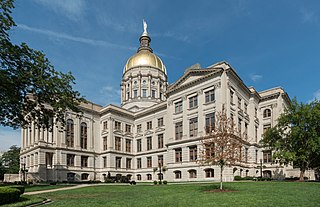
The Georgia State Capitol is an architecturally and historically significant building in Atlanta, Georgia, United States. The building has been named a National Historic Landmark which is listed on the National Register of Historic Places. As the primary office building of Georgia's government, the capitol houses the offices of the governor, lieutenant governor, and secretary of state on the second floor, chambers in which the General Assembly, consisting of the Georgia State Senate and Georgia House of Representatives, meets annually from January to April. The fourth floor houses visitors' galleries overlooking the legislative chambers and a museum located near the rotunda in which a statue of Miss Freedom caps the dome.
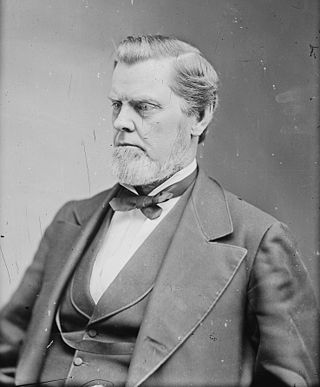
Benjamin Harvey Hill was a politician whose "flamboyant opposition" to Congressional Reconstruction is credited with helping inaugurate Georgia's Ku Klux Klan. His famous "brush arbor speech" in Atlanta on July 23, 1868, called for the use of violence against the governor, the legislature, and freed people. His career spanned state and national politics, and the Civil War. He served in the Georgia legislature in both houses. Although he initially opposed secession and was elected as a Unionist in 1860, he nonetheless voted to secede in that year, and represented Georgia as a Confederate senator during the conflict.
Confederate monuments and memorials in the United States include public displays and symbols of the Confederate States of America (CSA), Confederate leaders, or Confederate soldiers of the American Civil War. Many monuments and memorials have been or will be removed under great controversy. Part of the commemoration of the American Civil War, these symbols include monuments and statues, flags, holidays and other observances, and the names of schools, roads, parks, bridges, buildings, counties, cities, lakes, dams, military bases, and other public structures. In a December 2018 special report, Smithsonian Magazine stated, "over the past ten years, taxpayers have directed at least $40 million to Confederate monuments—statues, homes, parks, museums, libraries, and cemeteries—and to Confederate heritage organizations."

Alexander H. Stephens is a marble sculpture commemorating the American politician of the same name by Gutzon Borglum, installed in the United States Capitol as part of the National Statuary Hall Collection. The statue was gifted by the state of Georgia in 1927.

Jefferson Davis, created by Henry Augustus Lukeman, is a bronze sculpture of Jefferson Davis – a U.S. Senator, U.S. Secretary of War, plantation owner and the only President of the Confederate States of America during the American Civil War – commissioned by the U.S. State of Mississippi for inclusion in National Statuary Hall Collection at the United States Capitol's National Statuary Hall, in Washington, D.C. The statue was controversial at the time of its unveiling and there have been multiple efforts to remove it from the Capitol since 2015.

The Four Southern Poets Monument, also known as the Monument to Southern Poets and Poets' Monument, is a granite monument in Augusta, Georgia, in the United States.
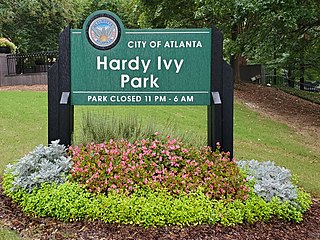
Hardy Ivy Park is a pocket park in downtown Atlanta, Georgia, United States.

The Erskine Memorial Fountain is a public fountain in Grant Park of Atlanta, Georgia, United States. Designed by J. Massey Rhind in honor of John Erskine, it was the first public fountain in Atlanta. The fountain was built in 1896 and moved to its current location in 1912.
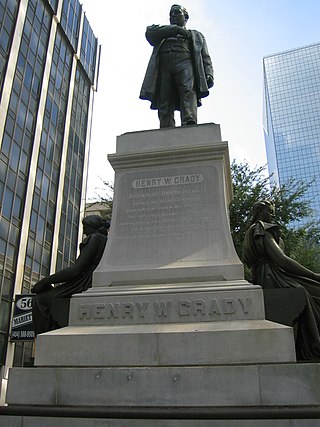
The Henry W. Grady statue is a monumental statue of Henry W. Grady in Atlanta, Georgia, United States. Built by Alexander Doyle in 1891, the statue lies at the intersection of Marietta Street and Forsyth Street in downtown Atlanta and was unveiled shortly after Grady's death in 1889. The statue has recently been the subject of controversy, as several groups have called for its removal due to Grady's support of white supremacy.
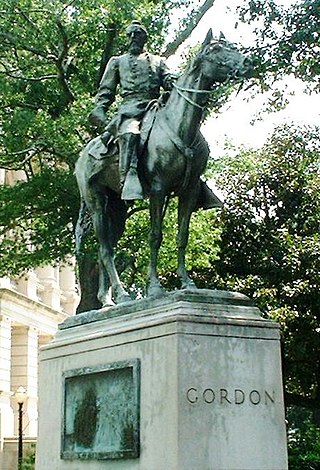
The equestrian statue of John Brown Gordon is a monument on the grounds of the Georgia State Capitol in Atlanta, Georgia, United States. The monument, an equestrian statue, honors John Brown Gordon, a general in the Confederate States Army during the American Civil War who later become a politician in post-Reconstruction era Georgia. Designed by Solon Borglum, the statue was dedicated in 1907 to large fanfare. The statue has recently become a figure of controversy over Gordon's racist views and associations with the Confederacy, with some calling for its removal.

The Martin Luther King Jr. statue is a public monument of civil rights activist Martin Luther King Jr. in Atlanta, Georgia. The statue, designed by Martin Dawe, was unveiled in 2017 and stands on the grounds of the Georgia State Capitol, overlooking Liberty Plaza.

The Eugene Talmadge statue is a public monument located on the grounds of the Georgia State Capitol in Atlanta, Georgia. Designed by Steffen Thomas, the statue was unveiled in 1949 and depicts Georgia Governor Eugene Talmadge. The statue has been the subject of recent controversy given Talmadge's white supremacist and racist views.

The statue of Thomas E. Watson is a public monument located near the Georgia State Capitol in Atlanta, Georgia. Dedicated in 1932, the statue honors Georgian politician Thomas E. Watson, who served terms in the United States Congress as both a Representative and Senator in the late 1800s and early 1900s. Originally located on the steps of the capitol building, the statue was removed from this location in 2013 and relocated to a nearby plaza.

The Thomas W. Talbot Monument is a public monument dedicated to Thomas W. Talbot in Atlanta, Georgia, United States. Located in Grant Park, the monument was dedicated in 1948 to Talbot, who had founded what is now the International Association of Machinists and Aerospace Workers in the city in 1888.

Pioneer Women is a memorial in Atlanta, Georgia, United States. Located in Piedmont Park, the memorial, designed by Steffen Thomas, was dedicated in 1938 by the Atlanta Pioneer Women's Society to honor former members of the group.

Pershing Point Park, also known as Pershing Point Memorial Park, is a small public park in Atlanta, Georgia, United States. The park, located in midtown Atlanta, is formed by the intersection of Peachtree Street and West Peachtree Street. It was dedicated in the 1920s in honor of General of the Armies John J. Pershing and includes a memorial to Fulton County soldiers who died in World War I. The World Athletes Monument is also located in the park. A 2018 article in The Atlanta Journal-Constitution listed the park as one of three World War I memorials in the Atlanta metropolitan area.

The Illinois Monument is a public monument located in the Kennesaw Mountain National Battlefield Park in Cobb County, Georgia, United States. The monument honors the soldiers from Illinois who fought in the Battle of Kennesaw Mountain during the Atlanta campaign of the American Civil War. It is located on Cheatham Hill, the site of intense fighting during the battle, and was dedicated in 1914, on the 50th anniversary of the battle. It was designed by Mario Korbel and James Dibelka.


















